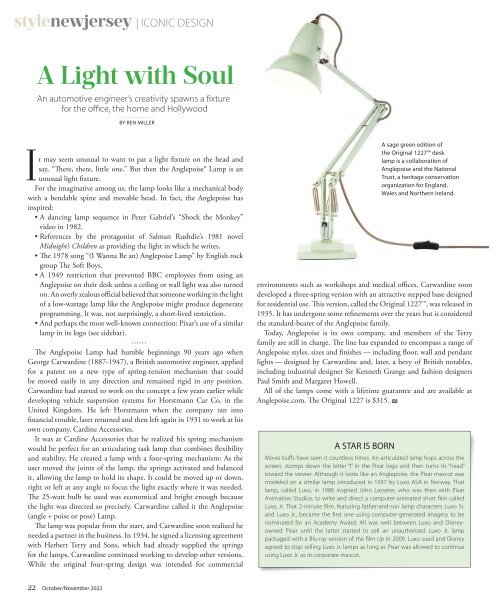DesignNJ_OctNov 22_Digital Issue
Our October/November issue, now arriving in mailboxes, highlights a range of homes — from an edgy remake of traditional to relaxing shore homes that families enjoy year-round. We are making this complete issue available in digital format to inspire and inform homeowners across the state. If you are interested in subscribing to the print edition, visit www.designnewjersey.com/subscribe.
Our October/November issue, now arriving in mailboxes, highlights a range of homes — from an edgy remake of traditional to relaxing shore homes that families enjoy year-round. We are making this complete issue available in digital format to inspire and inform homeowners across the state. If you are interested in subscribing to the print edition, visit www.designnewjersey.com/subscribe.
- TAGS
- exterior
- furnishings
- interior
You also want an ePaper? Increase the reach of your titles
YUMPU automatically turns print PDFs into web optimized ePapers that Google loves.
stylenewjersey | ICONIC DESIGN<br />
A Light with Soul<br />
An automotive engineer’s creativity spawns a fixture<br />
for the office, the home and Hollywood<br />
BY REN MILLER<br />
It may seem unusual to want to pat a light fixture on the head and<br />
say, “There, there, little one.” But then the Anglepoise® Lamp is an<br />
unusual light fixture.<br />
For the imaginative among us, the lamp looks like a mechanical body<br />
with a bendable spine and movable head. In fact, the Anglepoise has<br />
inspired:<br />
• A dancing lamp sequence in Peter Gabriel’s “Shock the Monkey”<br />
video in 1982.<br />
• References by the protagonist of Salman Rushdie’s 1981 novel<br />
Midnight’s Children as providing the light in which he writes.<br />
• The 1978 song “(I Wanna Be an) Anglepoise Lamp” by English rock<br />
group The Soft Boys.<br />
• A 1949 restriction that prevented BBC employees from using an<br />
Anglepoise on their desk unless a ceiling or wall light was also turned<br />
on. An overly zealous official believed that someone working in the light<br />
of a low-wattage lamp like the Anglepoise might produce degenerate<br />
programming. It was, not surprisingly, a short-lived restriction.<br />
• And perhaps the most well-known connection: Pixar’s use of a similar<br />
lamp in its logo (see sidebar).<br />
……<br />
The Anglepoise Lamp had humble beginnings 90 years ago when<br />
George Carwardine (1887-1947), a British automotive engineer, applied<br />
for a patent on a new type of spring-tension mechanism that could<br />
be moved easily in any direction and remained rigid in any position.<br />
Carwardine had started to work on the concept a few years earlier while<br />
developing vehicle suspension systems for Horstmann Car Co. in the<br />
United Kingdom. He left Horstmann when the company ran into<br />
financial trouble, later returned and then left again in 1931 to work at his<br />
own company, Cardine Accessories.<br />
It was at Cardine Accessories that he realized his spring mechanism<br />
would be perfect for an articulating task lamp that combines flexibility<br />
and stability. He created a lamp with a four-spring mechanism: As the<br />
user moved the joints of the lamp, the springs activated and balanced<br />
it, allowing the lamp to hold its shape. It could be moved up or down,<br />
right or left at any angle to focus the light exactly where it was needed.<br />
The 25-watt bulb he used was economical and bright enough because<br />
the light was directed so precisely. Carwardine called it the Anglepoise<br />
(angle + poise or pose) Lamp.<br />
The lamp was popular from the start, and Carwardine soon realized he<br />
needed a partner in the business. In 1934, he signed a licensing agreement<br />
with Herbert Terry and Sons, which had already supplied the springs<br />
for the lamps. Carwardine continued working to develop other versions.<br />
While the original four-spring design was intended for commercial<br />
environments such as workshops and medical offices, Carwardine soon<br />
developed a three-spring version with an attractive stepped base designed<br />
for residential use. This version, called the Original 1<strong>22</strong>7, was released in<br />
1935. It has undergone some refinements over the years but is considered<br />
the standard-bearer of the Anglepoise family.<br />
Today, Anglepoise is its own company, and members of the Terry<br />
family are still in charge. The line has expanded to encompass a range of<br />
Anglepoise styles, sizes and finishes — including floor, wall and pendant<br />
lights — designed by Carwardine and, later, a bevy of British notables,<br />
including industrial designer Sir Kenneth Grange and fashion designers<br />
Paul Smith and Margaret Howell.<br />
All of the lamps come with a lifetime guarantee and are available at<br />
Anglepoise.com. The Original 1<strong>22</strong>7 is $315. DNJ<br />
A STAR IS BORN<br />
A sage green edition of<br />
the Original 1<strong>22</strong>7 desk<br />
lamp is a collaboration of<br />
Anglepoise and the National<br />
Trust, a heritage conservation<br />
organization for England,<br />
Wales and Northern Ireland.<br />
Movie buffs have seen it countless times. An articulated lamp hops across the<br />
screen, stomps down the letter “I” in the Pixar logo and then turns its “head”<br />
toward the viewer. Although it looks like an Anglepoise, the Pixar mascot was<br />
modeled on a similar lamp introduced in 1937 by Luxo ASA in Norway. That<br />
lamp, called Luxo, in 1986 inspired John Lasseter, who was then with Pixar<br />
Animation Studios, to write and direct a computer-animated short film called<br />
Luxo, Jr. That 2-minute film, featuring father-and-son lamp characters Luxo Sr.<br />
and Luxo Jr., became the first one using computer-generated imagery to be<br />
nominated for an Academy Award. All was well between Luxo and Disneyowned<br />
Pixar until the latter started to sell an unauthorized Luxo Jr. lamp<br />
packaged with a Blu-ray version of the film Up in 2009. Luxo sued and Disney<br />
agreed to stop selling Luxo Jr. lamps as long as Pixar was allowed to continue<br />
using Luxo Jr. as its corporate mascot.<br />
<strong>22</strong> October/November 20<strong>22</strong>
















